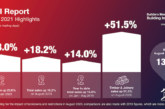The lending market for SME housebuilders remained robust in 2020 despite the economic impact of Covid-19, research from real estate finance advisory LEXI Finance reveals.
The real estate finance market experienced a severe retraction during the first lockdown when the housing market was effectively shut. The second quarter in 2020, the period of most uncertainty in the funding market, saw lending fall off a cliff, dropping by 30 percent year on year. This represents a mammoth change in a market more used to measuring change in the low single digits.
However, despite the pause in Q2 2020, over 120 lenders resumed funding SME developers by the end of the year. By Q4 2020 activity had rebounded and overshot levels of funding seen in Q4 2019.
This reaction stands in sharp contrast to the response of the lending market following the GFC, with only 30 lenders remaining active in 2010. Comparatively, the financing market in 2020 contained four times as many development lenders. This is despite the economic impact of Covid-19, which has seen the UK suffer its largest drop in economic output in over 300 years, far worse than during the GFC.
This contrast will in part be due to the altered make-up of the lending landscape, which has changed dramatically over the last decade. The once-dominant high street banks have retrenched; now only funding the larger PLC housebuilders and projects requiring the lowest leverage. In their place, a range of alternative lenders like challenger banks, debt funds, family offices and peer-to-peer platforms – many of whom did not exist pre-GFC – have taken up the mantle and built-up sizable market share.
These new participants look at lending differently. They rely on a diverse array of funding lines and have varying approaches to risk. The market no longer relies on one pool of similar lenders and does not suffer from major disruption if a handful of participants pause. This post-GFC fragmentation, it appears, has created resilience.
The other major factor in the market’s post-Covid-outbreak strength is government assistance, which dwarfs the monetary response to the GFC. Last year we saw the Chancellor support property through stamp duty relief, interest payment holidays and more recently a return to 95% mortgages. On the lending side, we’ve seen support through CBILS loans and Bounce Back loans, all underwritten by the British Business Bank and guaranteed by the Exchequer.
This protection has dragged otherwise hesitant lenders back to the market and, most importantly, provided momentum as the country gets back on its feet. Although CBILS was launched in March 2020, its real impact in the market was seen Q4, when accredited lenders were most active in deploying loans. This has fed through into the data, which shows that 44% of all development finance loans were made in Q4 last year.
A good example of these trends in action is a loan recently structured by LEXI Finance on behalf of Daniel James Developments. The Essex based housebuilder was provided with a facility of 67 percent loan to gross development value for a housing scheme in Writtle, Chelmsford. The lender, Assetz Capital, who did not exist before the GFC, was supported by a government-backed CBILS guarantee that enabled the lend.
Sam Le Pard, co-founder at LEXI Finance, comments: “We’re still seeing the economic impact of the pandemic pan out. Whilst many lenders remain hesitant about certain types of commercial property, the market funding housebuilders is bullish. Partly this resilience stems from the fragmentation which occurred following 2008, but it has also clearly been driven by massive levels of government support. The development finance market may have needed a shot in the arm as much as the rest of the county, but now it’s back.
“Help for all corners of the lending market will remain invaluable if we are to meet the country’s need for new homes. Whilst the high-volume PLC housebuilders will continue to be supported by high street banks, it is the continued strength of the lenders supporting SME developers that will be crucial.”









